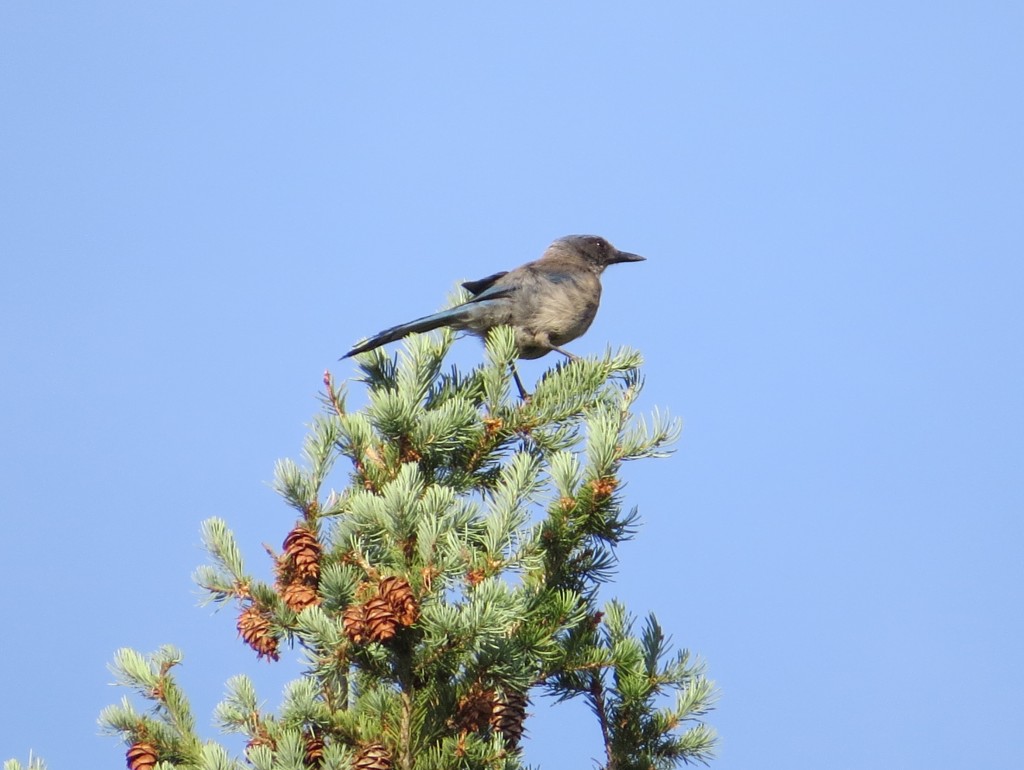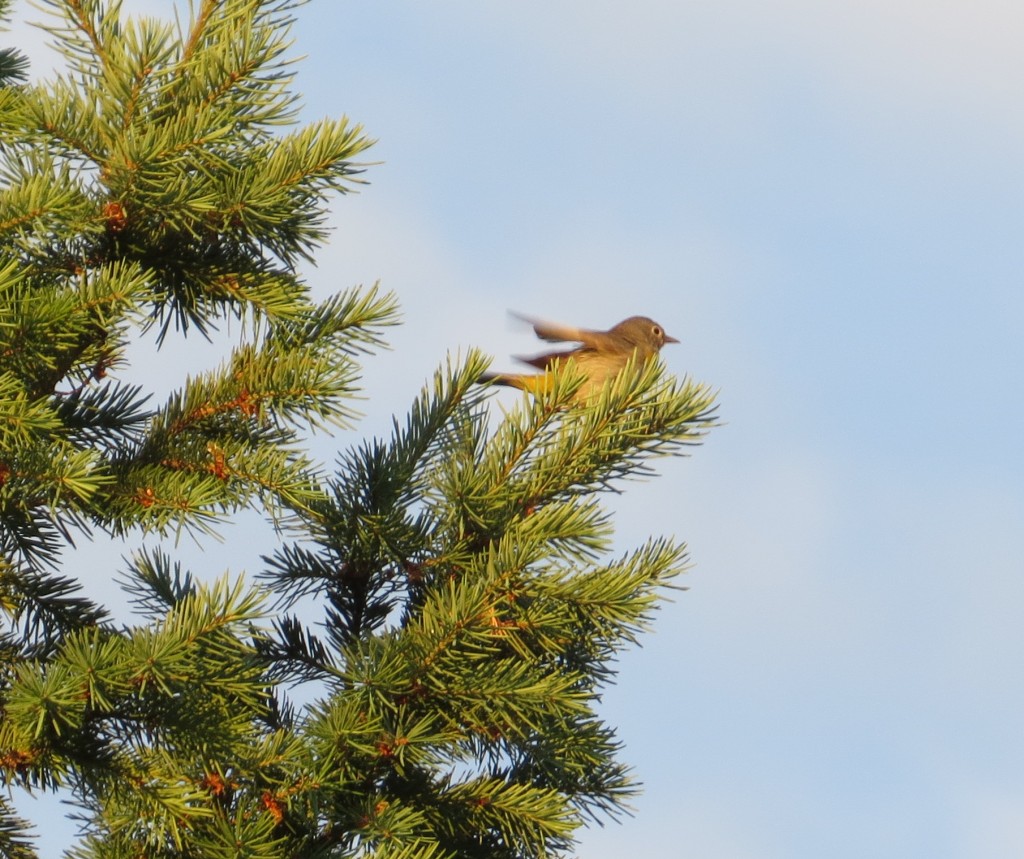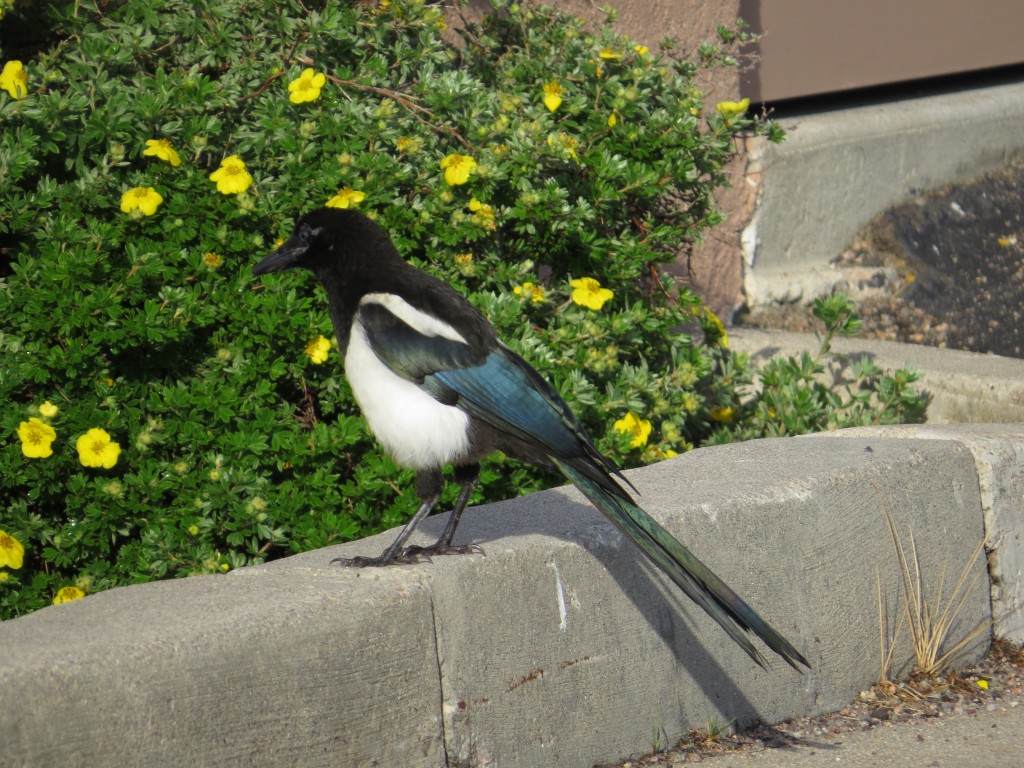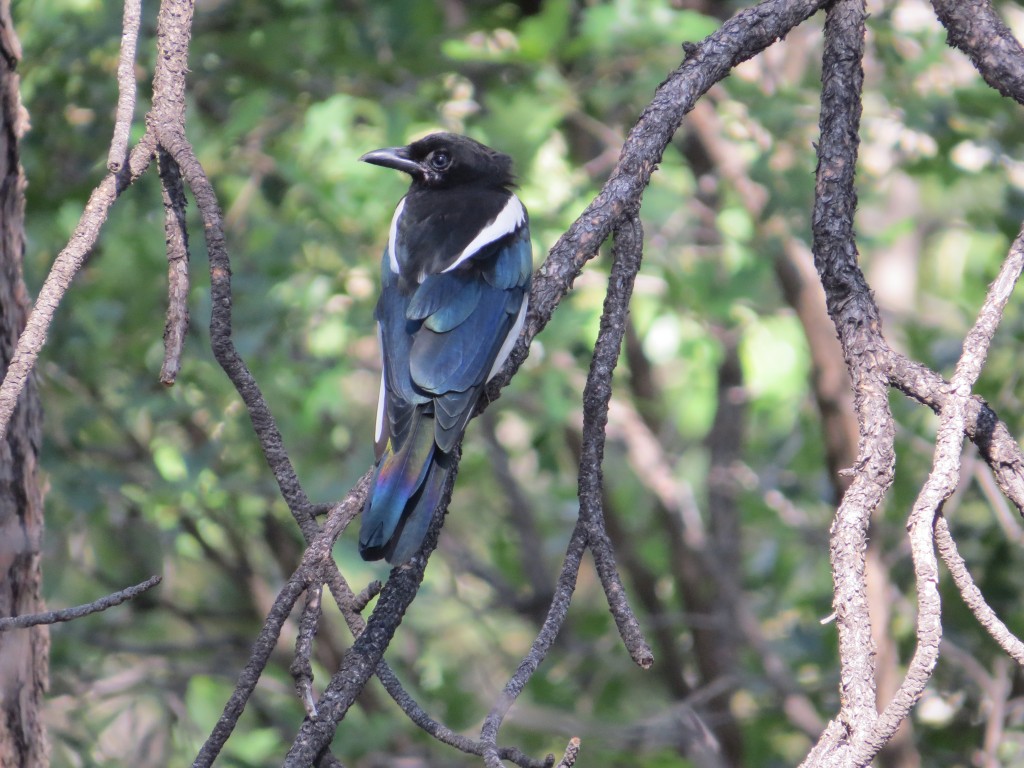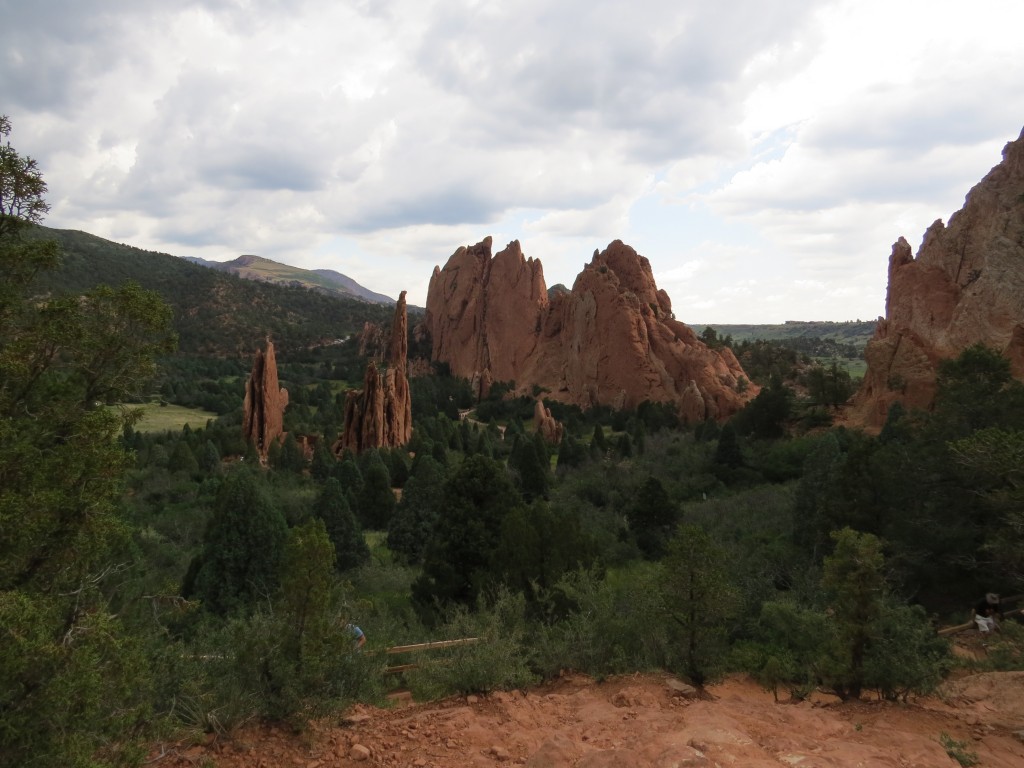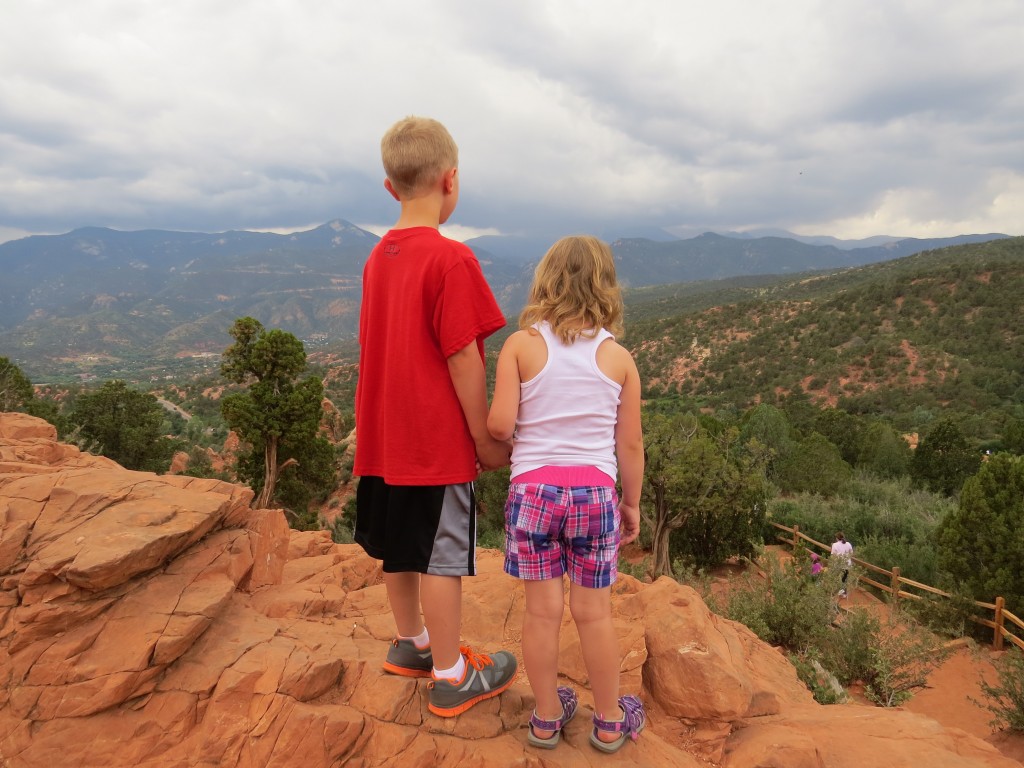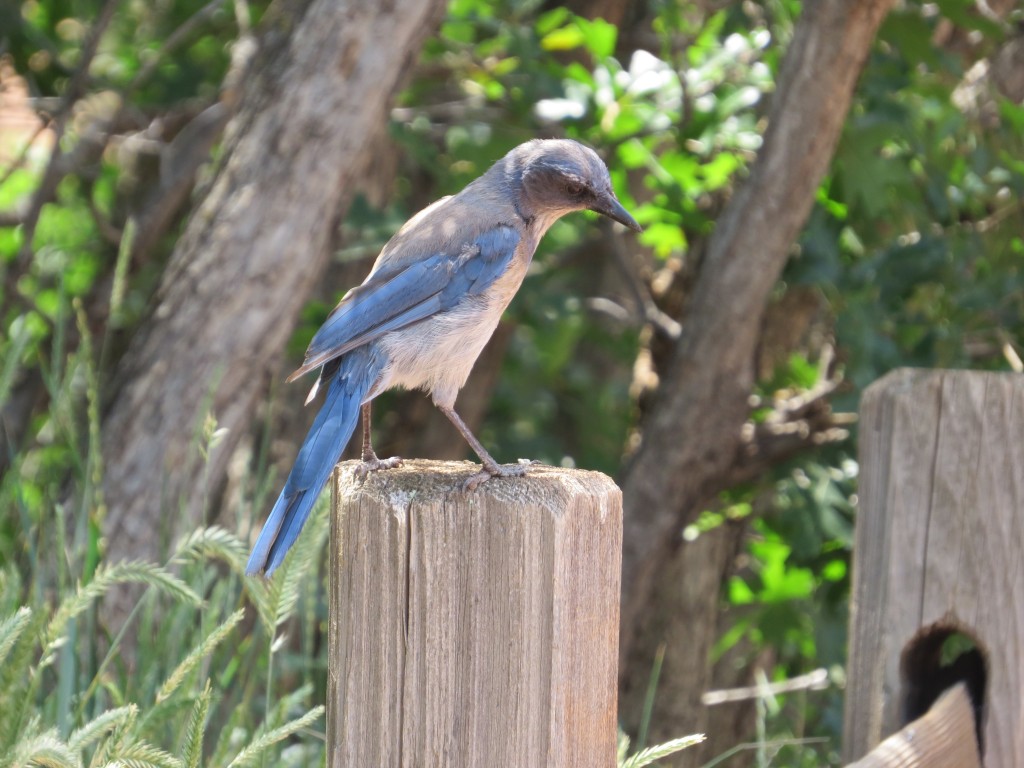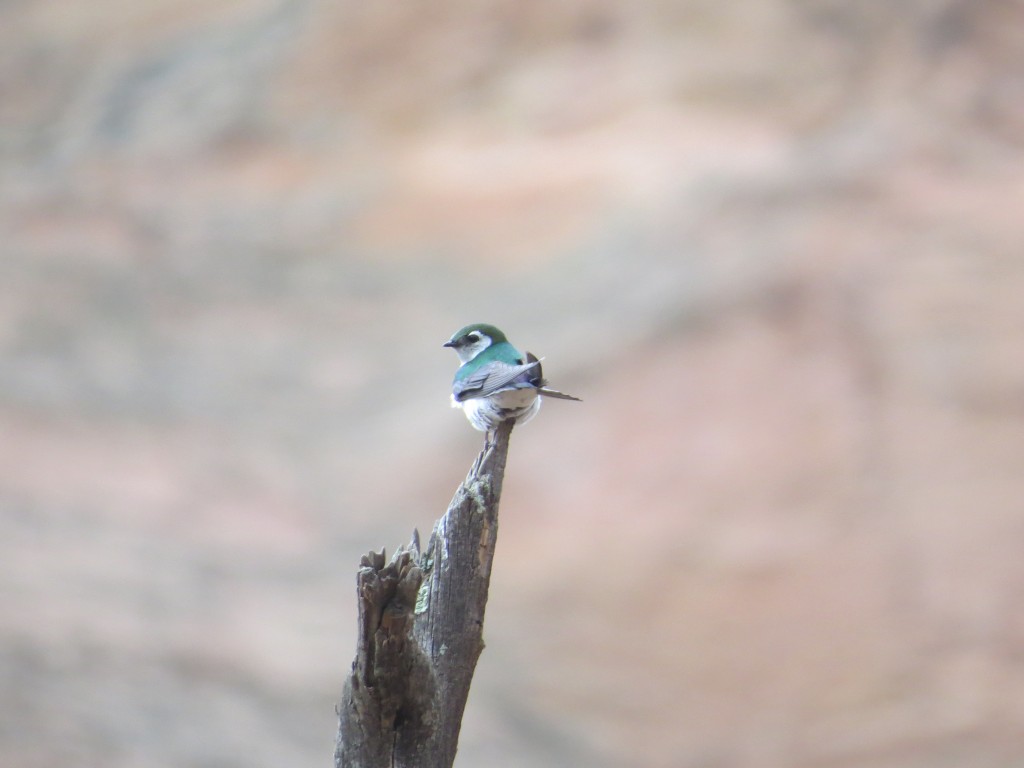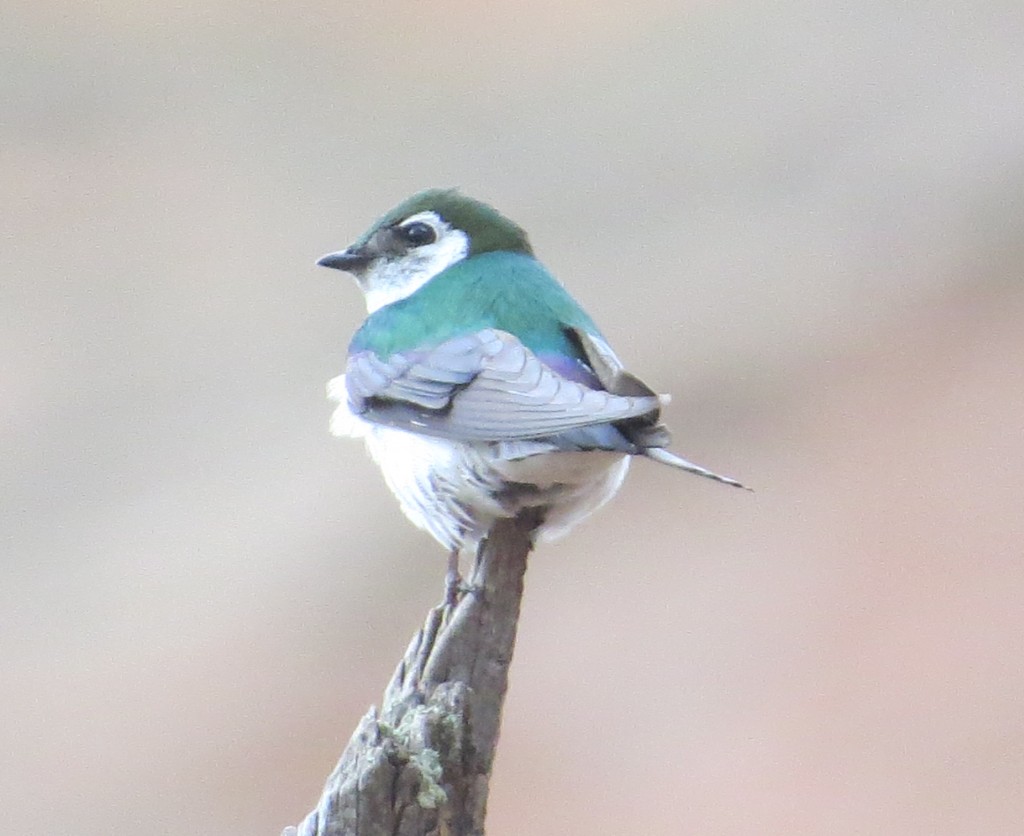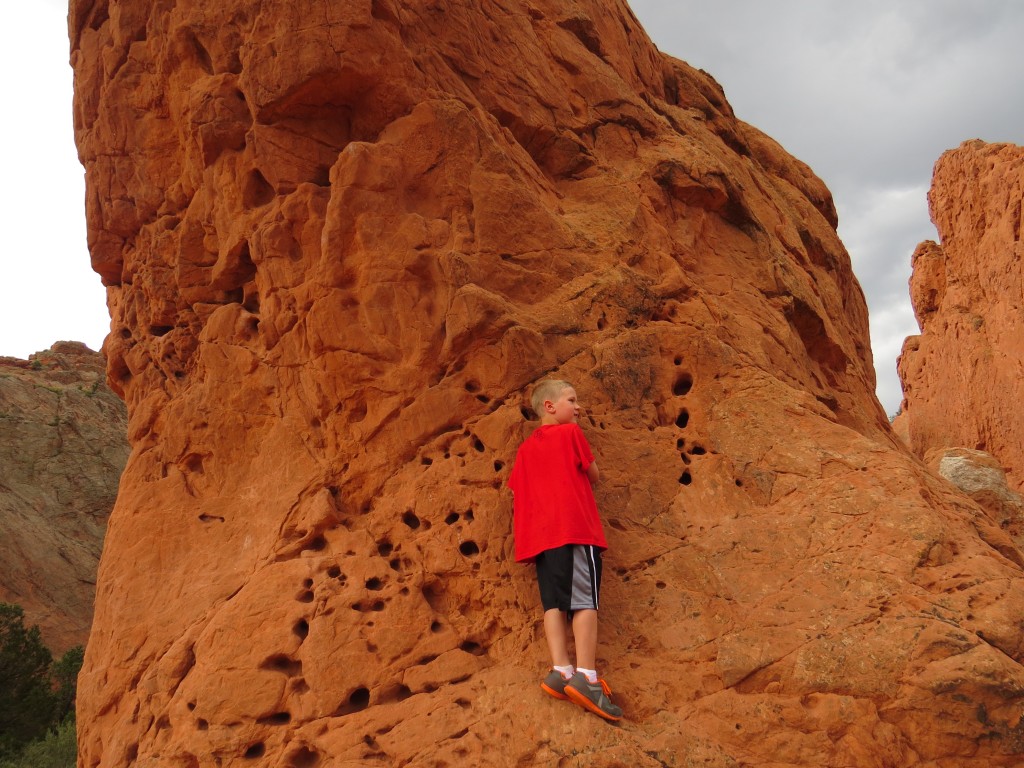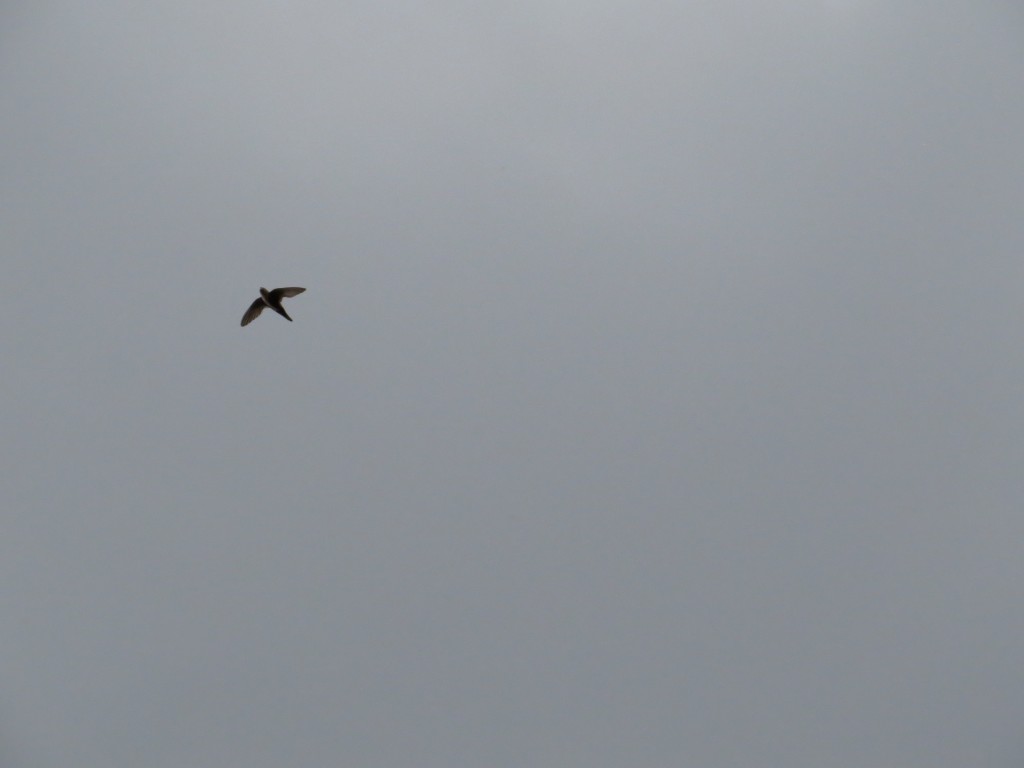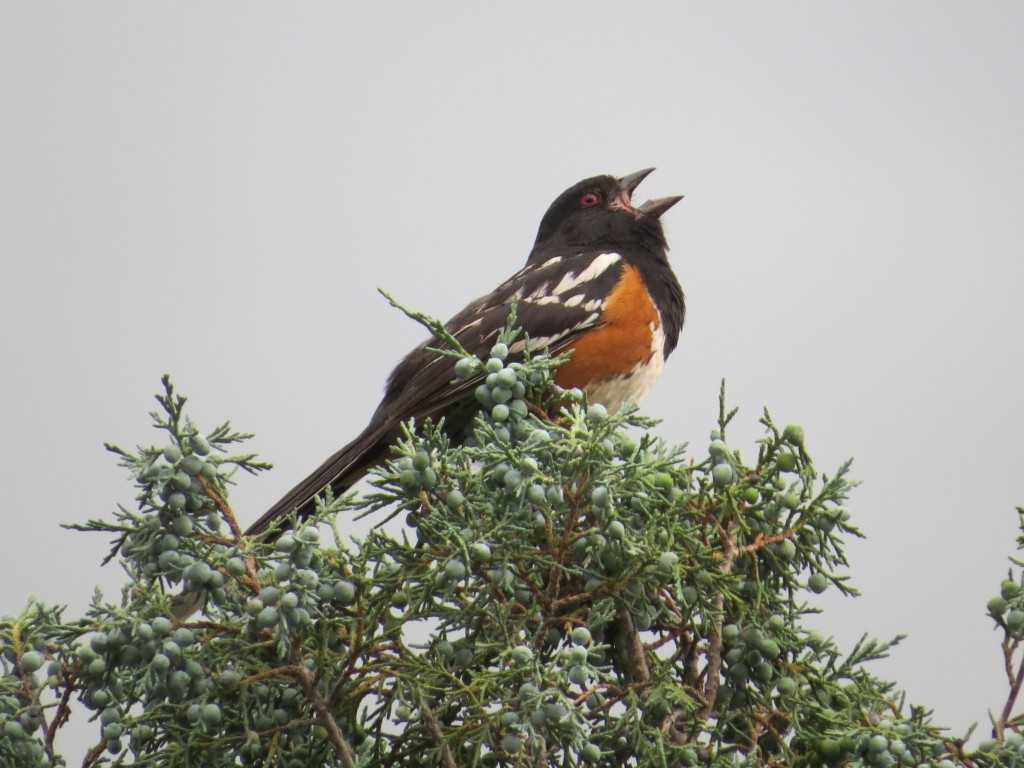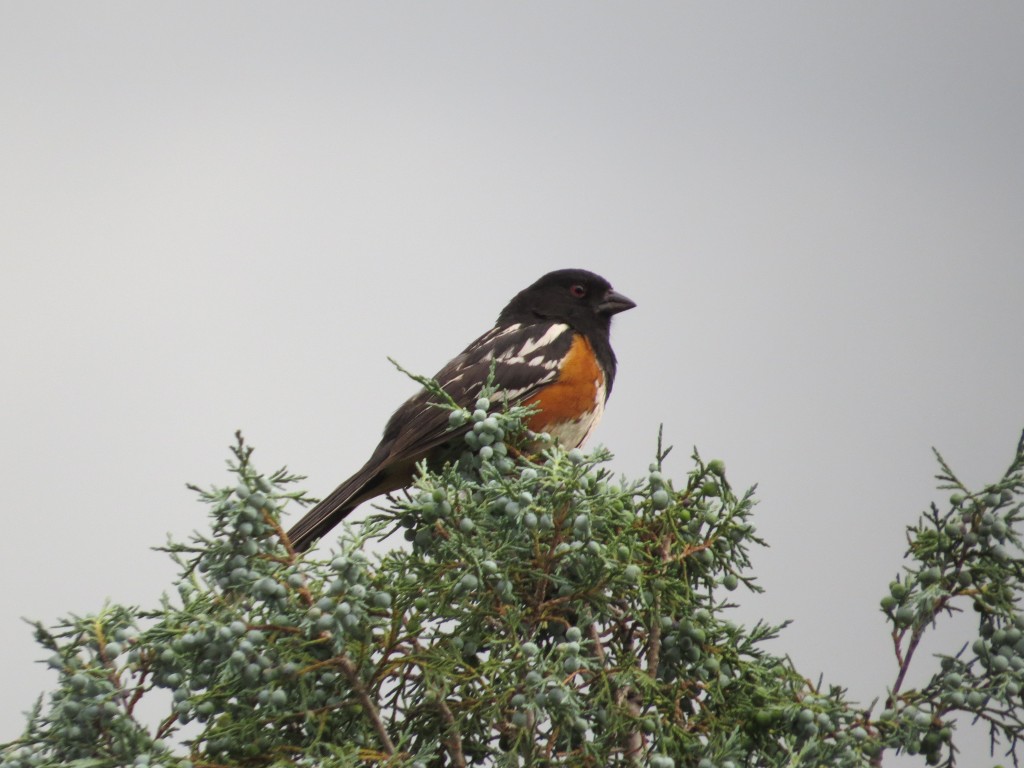After racking up 11 lifers from a mere two hours of dedicated birding and even less time from happenstance birding along the highways and biways, this trip had already been phenomenal. Now if the opposite were true, one could use the oft-quoted phrase, “There’s nowhere to go but up.” But this is Colorado, after all, so that phrase is still applicable whether you’re on a mountain-top high of birding or just on an actual mountain-top. And we proved it so in Custer County where my Aunt Carol and Uncle Jon live, our final Colorado destination.
As I had done previously, I did a fair amount of eBird scouting for this new terrain we were about to traverse. In particular I wanted one bird more than any other – the Western Tanager. A bright yellow and black bird with a red face is something I just had to see for myself. Some life birds are more than just checks on a list; their mind-blowing beauty haunts you until you’ve finally put them to rest. Though I tried, I could not spot this conifer forest dweller in the Blackhills of South Dakota. My next attempt would have to be in the mountains of south-central Colorado.
It turns out that one eBird report by Rich Miller of two Western Tanagers was conveniently located along the Greenwood Road which paralled our highway as we made our way through the Wet Mountains along the Hardscrabble Pass. I nearly missed this unassuming road but saw it at the last minute and did what any birder would do – swerve hard and jolt the non-birding occupants. As we puttered along this road, I really didn’t expect to see the tanager. It was just a chance I was taking. I knew that I’d probably have to search for it properly once we got settled at my aunt and uncle’s place. But then it magically happened – almost too perfect. A flash of brilliant yellow and black cut across the road interrupting – or rather accentuating – our sky blue and forest green vista. Unbelievable! The car was immediately rendered immobile and the hunt was on. I hopped out and watched and watched where it landed but did not see it. Evan was still in the car at this point waiting for me to do the heavy-lifting of finding the bird. He wanted to see it bad too, but he apparently needed a sure thing in order to take his attention off his iPad. As luck would have it, though, the bird flew back to the other side of the road! I motioned for Evan to come out. Now I had to do two things at once – point out the bird and try to get a photo. I was not very successful at either.
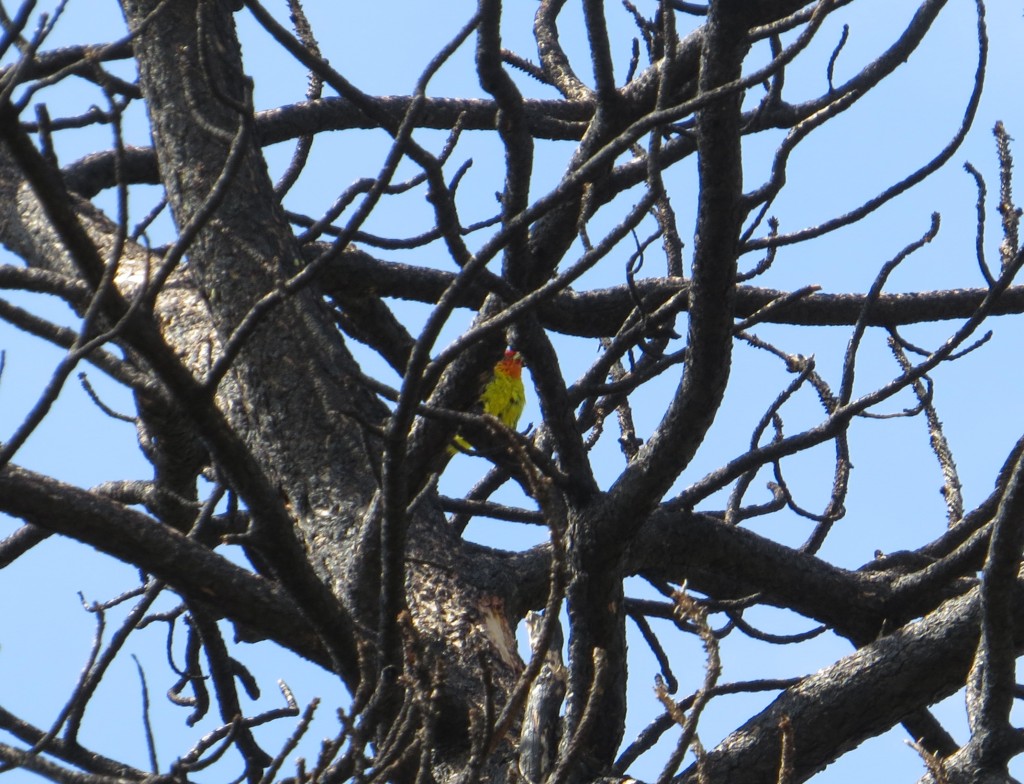
Western Tanager
How does a bird hide in a dead tree? Moreover, how did I not see a yellow, red, and black bird leave a dead tree with a blue sky background? Evan claimed he could still see it up there and I believed him. But five minutes later after I couldn’t find it and he still claimed he was looking at it in the exact same spot, I had to break the news to him that he was not looking at the bird or even a bird at all. Then the tears set in – not necessarily because he didn’t see it, but because Dad had seen it and he didn’t. That’s a stinging feeling that every birder has felt at some point. The “You should have been here 5-minutes ago” or “You just missed it” phenomenon. We’ve all been there. Evan is at least honest enough to cry about it like the rest of us want to but can’t.
But we were moving on and moving upward and Evan calmed down. On this same road I saw an interesting bird checking out a hole in a dead tree. I had seen reports of Lewis’s Woodpeckers here, but I was really hoping it wasn’t a Lewis’s Woodpecker. Getting one that easy would have been frustrating since I woke up at 2 AM to make a 14-hour round-trip to the Canadian border to see one last November. Looking through the binoculars, I saw that it wasn’t! Even better was that it was a Western Bluebird lifer. Unfortunately Evan didn’t get a look and I couldn’t get a photo before it was gone. This one didn’t seem to bother him. Funny. Perhaps I’d been hyping that Western Tanager a little too much.
We eventually did make it to that lovely mountain home where the accomodations, the company, and the birding would all prove to be excellent. Oh, and the constant view of the Sangre de Cristo Mountains across the Wet Mountain Valley wasn’t bad either.
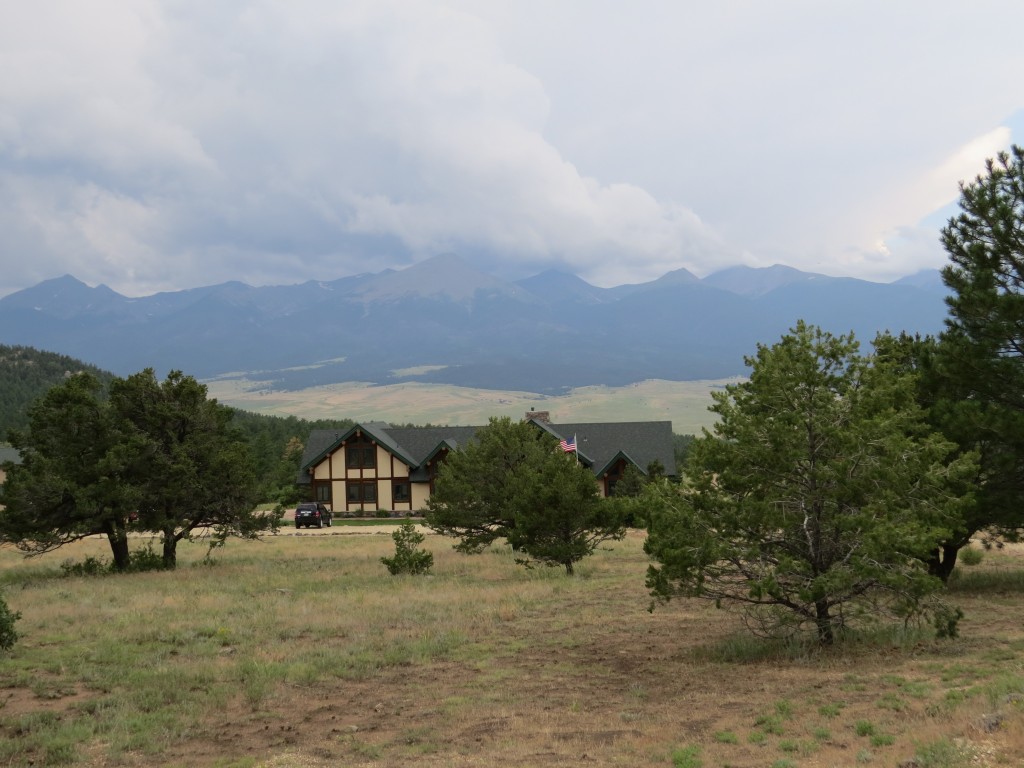 The yard-birding was fantastic here. I smiled as I heard and saw more Spotted Towhees than I could count, many of them cheerfully hopping just a few feet from me. Broad-tailed Hummingbirds were heard more often than seen as their metallic buzzing would alert you to their presence.
The yard-birding was fantastic here. I smiled as I heard and saw more Spotted Towhees than I could count, many of them cheerfully hopping just a few feet from me. Broad-tailed Hummingbirds were heard more often than seen as their metallic buzzing would alert you to their presence.
I was excited to get up early that next morning and poke around to see what I could find. Excited isn’t really the right word. I was like a 5-year-old on Christmas Eve. Morning finally came after a short, fitful sleep. The sounds were everywhere and new! I heard a grosbeak-like song and found its source at the top of a Ponderosa Pine, another Black-headed Grosbeak. The Spotted Towhees were sounding off everywhere. I tracked down one of the metallic buzzers to get this photo of the Broad-tailed Hummer who sat still long enough for me to get a couple shots.
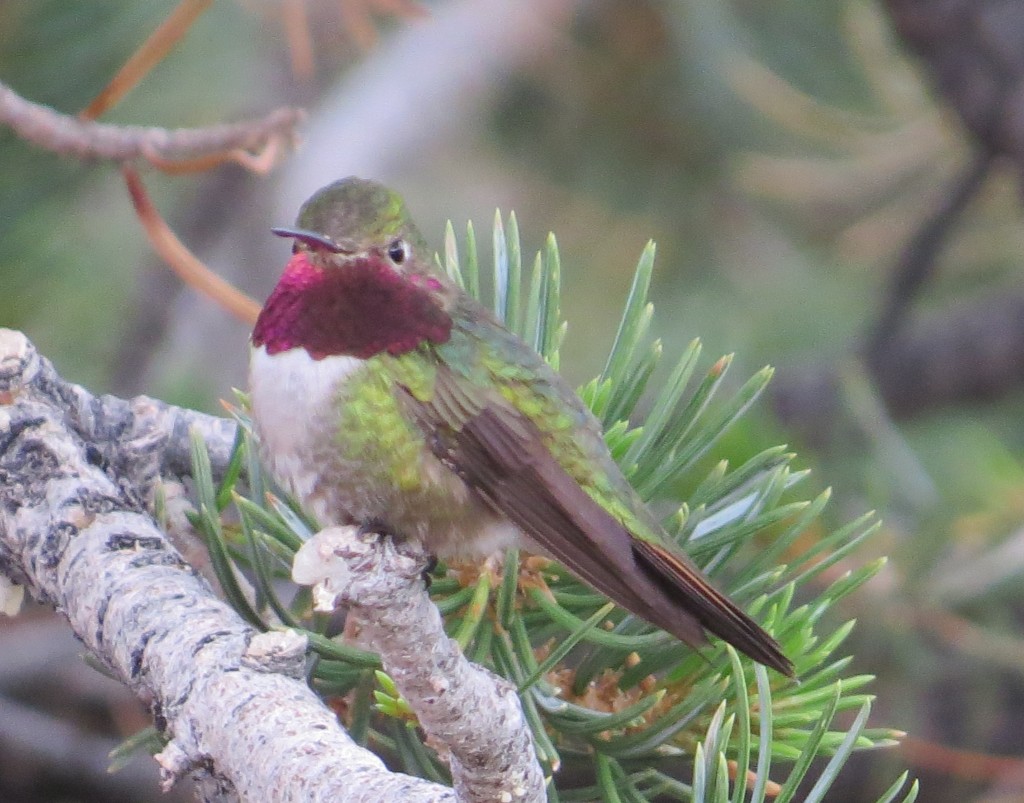
Broad-tailed Hummingbird
Among the many Broad-taileds doing aerial acrobatics, there was an orange-looking dude that was getting chased by the others. Hello! It was a Rufous Hummingbird! I got a quick look at one in Arizona last March, but this fella obliged me by letting snag a couple of up-close photos of him. I won’t even complain that the sun didn’t shine on his glorious red-throat. To see what that looks like, check out the header image at Butler’s Birds.
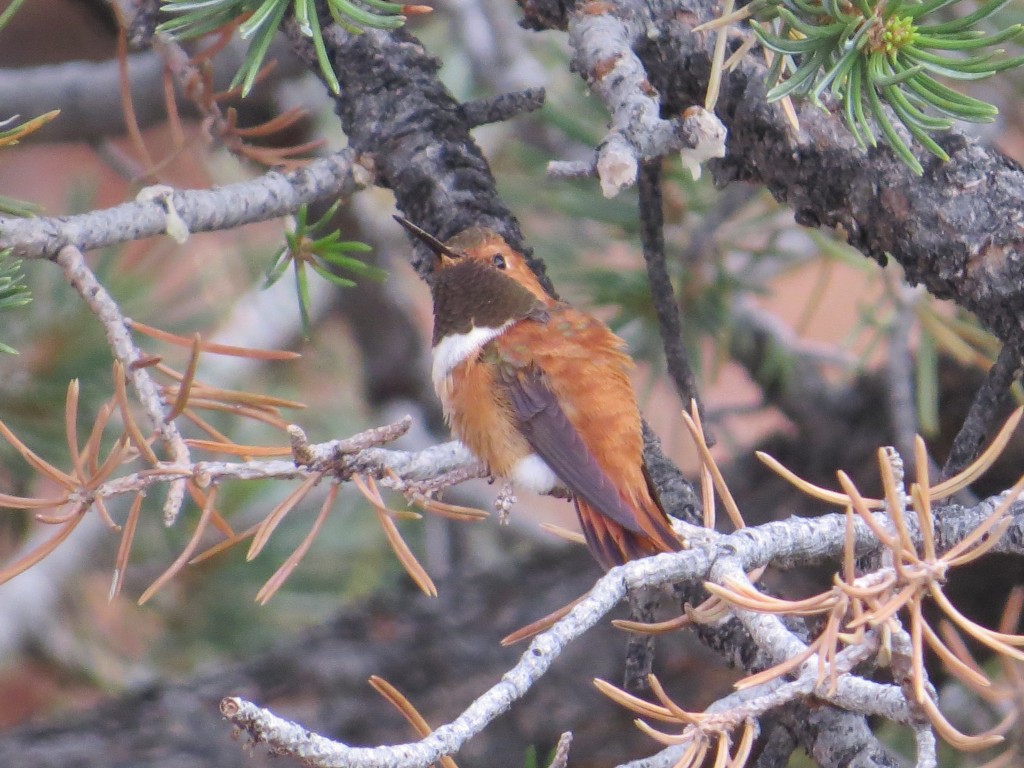
Rufous Hummingbird
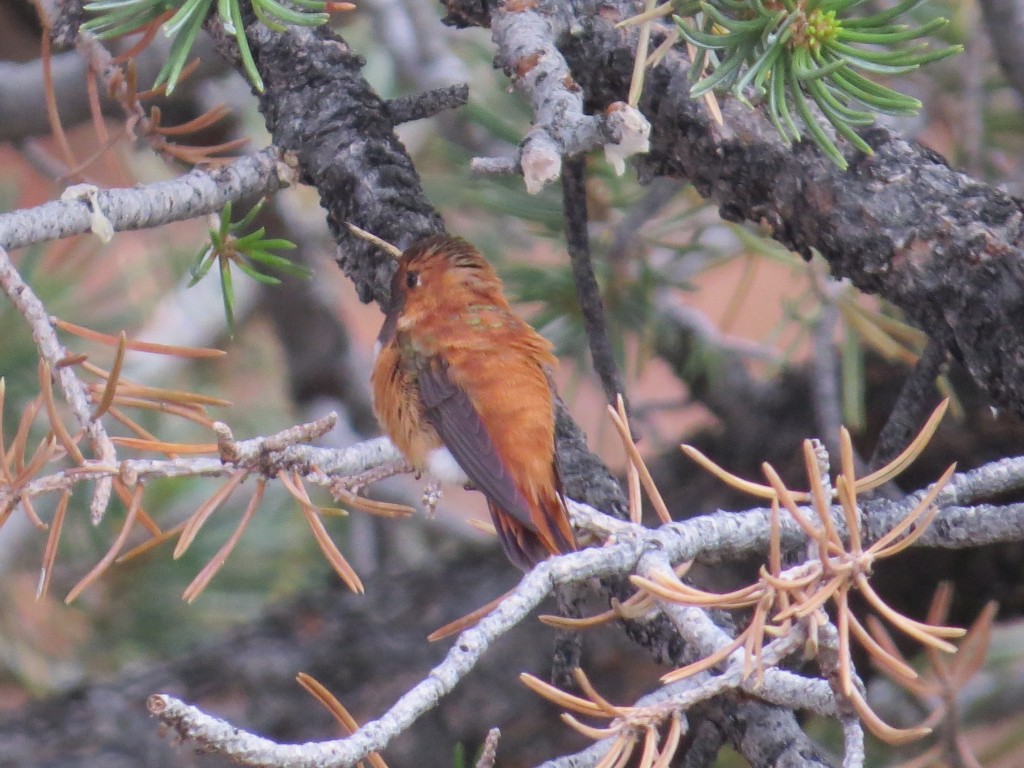 Its throat is really not black. To show you what I mean, here is another shot of that same Broad-tailed pictured above. It looks black here, but you can see above how red it really is when the sun hits it.
Its throat is really not black. To show you what I mean, here is another shot of that same Broad-tailed pictured above. It looks black here, but you can see above how red it really is when the sun hits it.
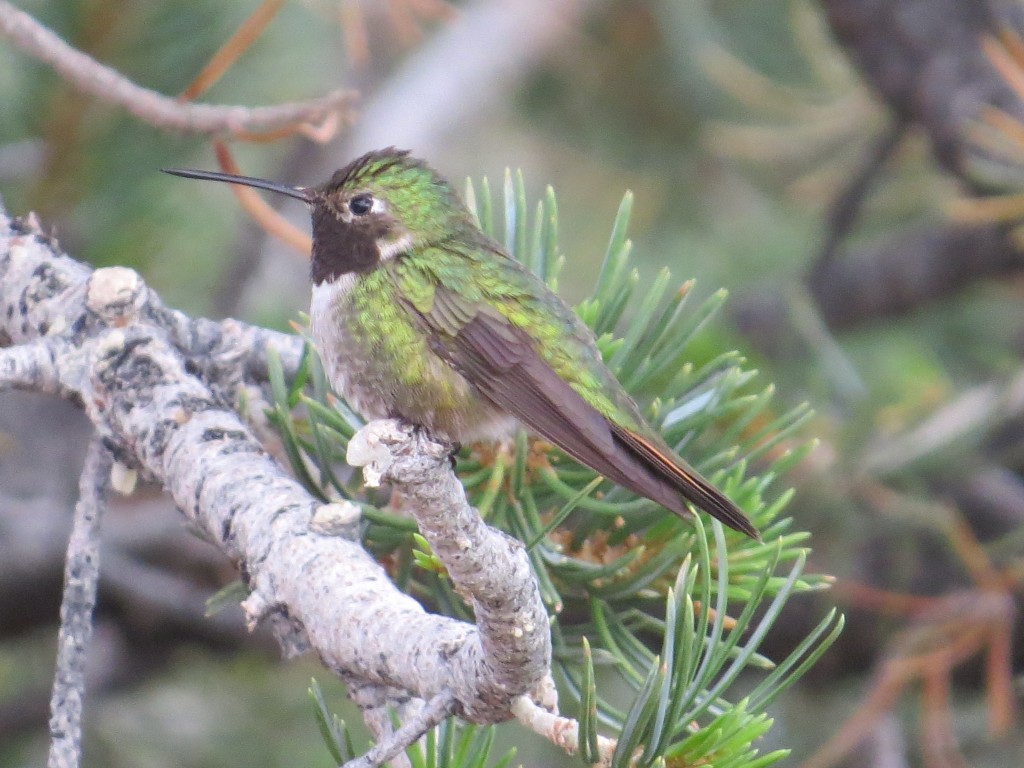
But in this land of flashy birds, there is also a dark side that tempers the excitement. I’m, of course, referring to those drab, confusing, hard-to-ID flycatchers. Based on vocalization and ruling out empids, I’m pretty sure I’ve got a Western Wood Pewee here. I hope any western readers will correct me if I’m wrong; I’m not proud.

Western Wood Pewee
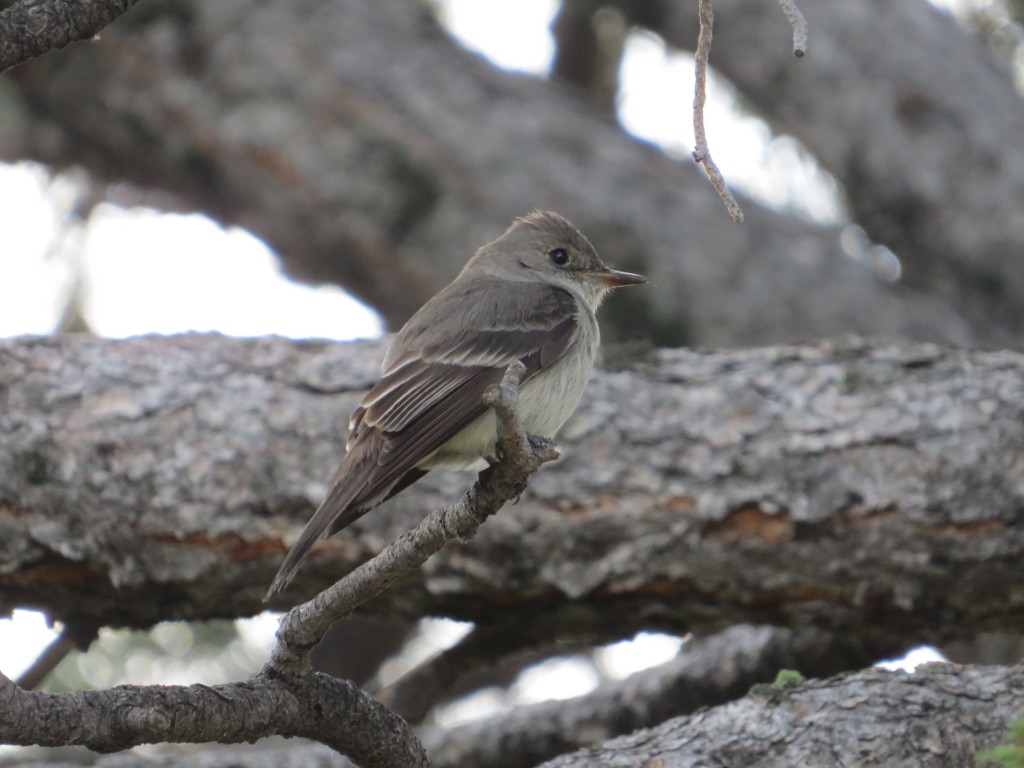 I did get an empid that I felt was a pretty solid ID with that yellow tinge and tear-drop eye-ring. This one is a Cordilleran Flycatcher. Life bird.
I did get an empid that I felt was a pretty solid ID with that yellow tinge and tear-drop eye-ring. This one is a Cordilleran Flycatcher. Life bird.
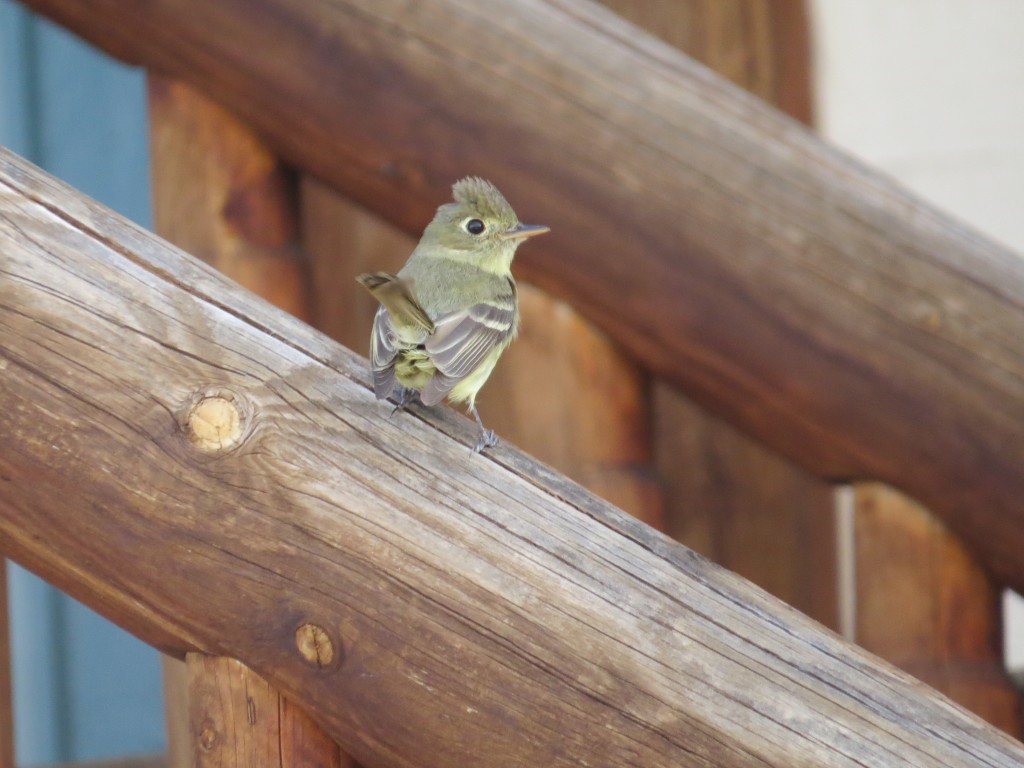
Cordilleran Flycatcher
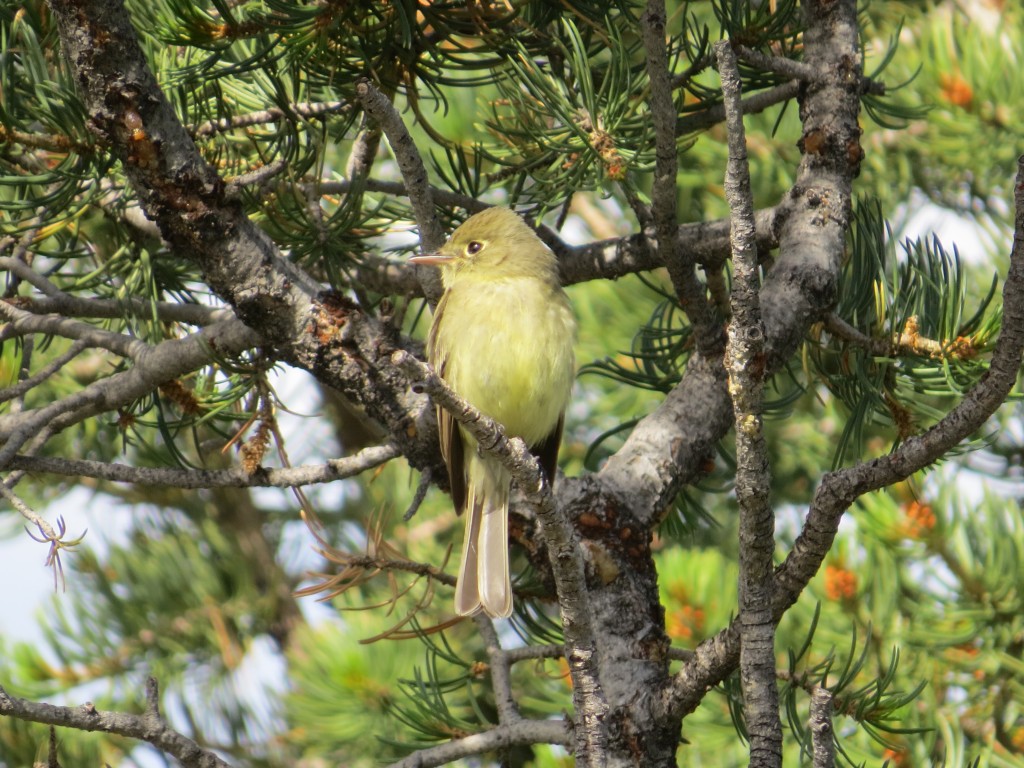 Then there was a life bird that was not hard to ID and whose name is not soon forgotten by birders or non-birders alike – the Bushtit! And the bushes, or Pinyon Pines rather, were hopping with these tiny Bushtits.
Then there was a life bird that was not hard to ID and whose name is not soon forgotten by birders or non-birders alike – the Bushtit! And the bushes, or Pinyon Pines rather, were hopping with these tiny Bushtits.
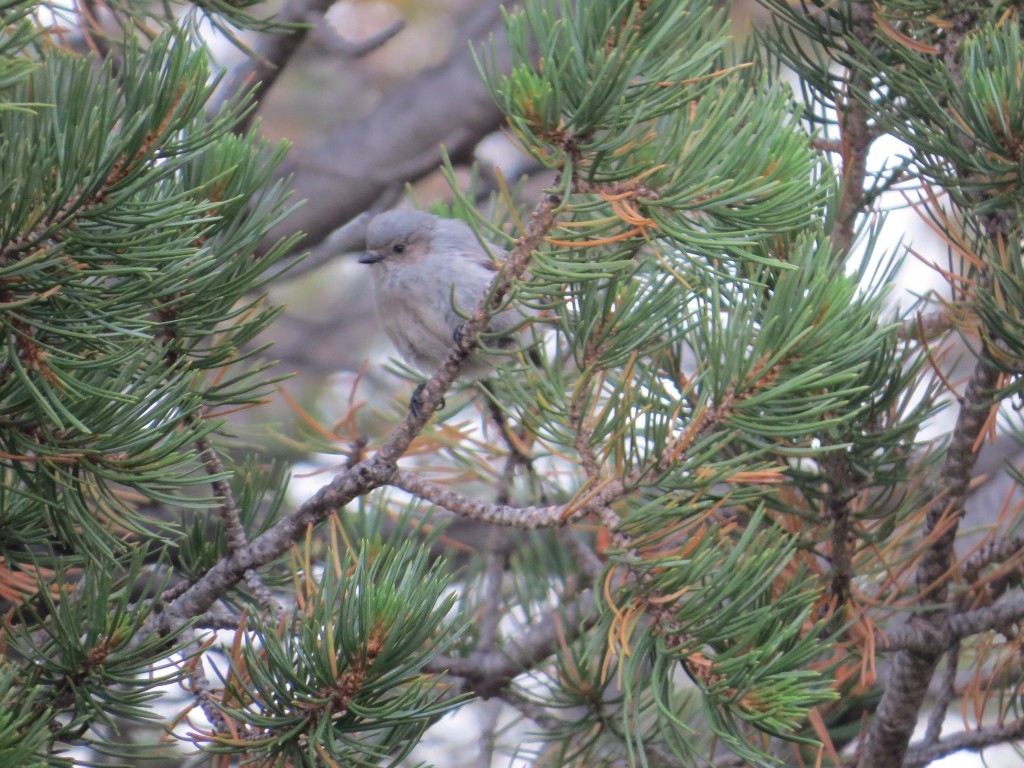
Bushtit – It’s okay to giggle.
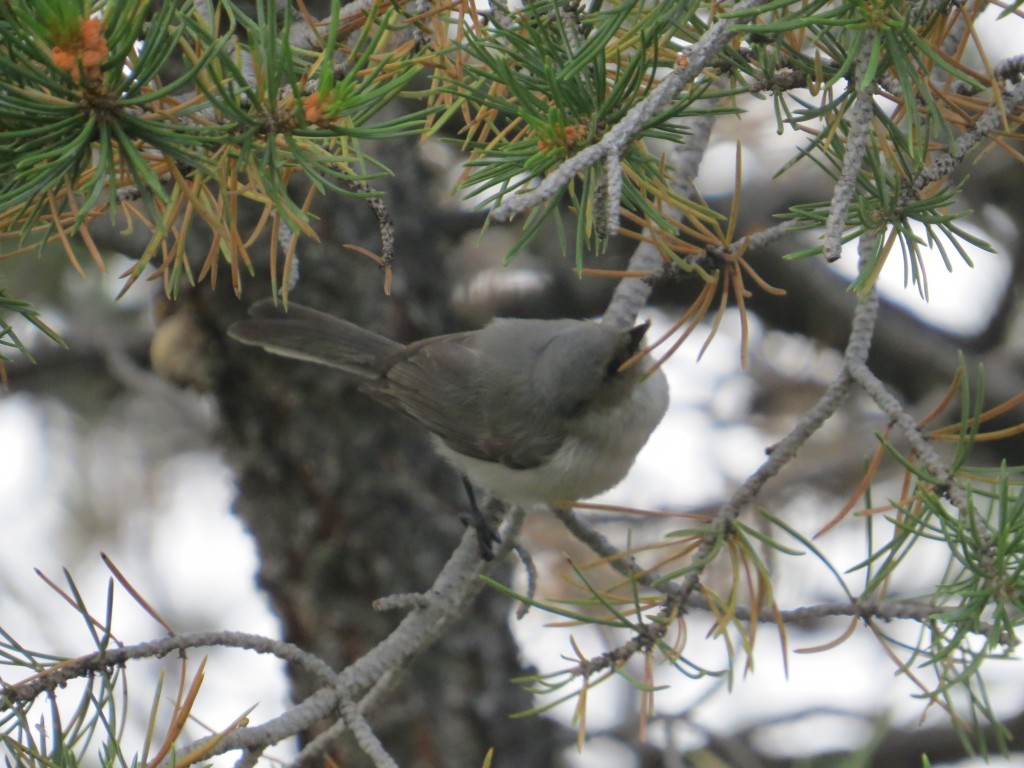
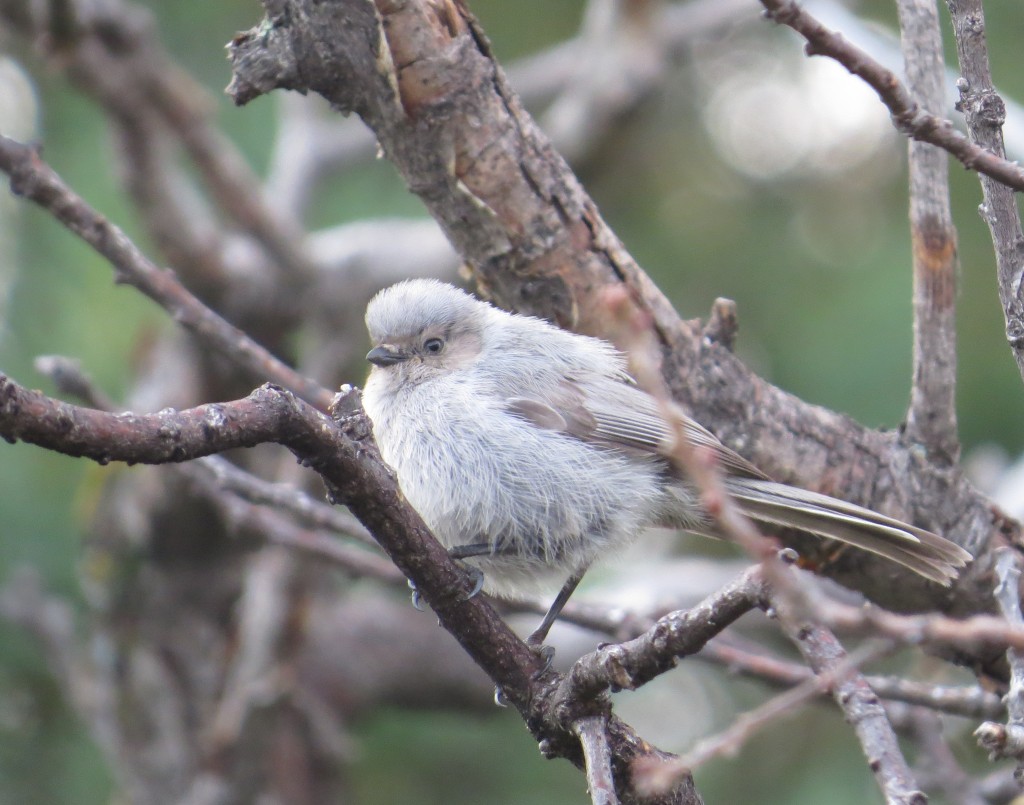 Aunt Carol kept giggling over the name when she asked what birds I saw. She even said she wanted to see some Bushtits for herself. At this point I’d like to take an aside to say that I’m glad Evan is learning all the “dirty” bird names now before he hits upper elementary. Names like Bushtits, Blue-footed Boobies, Brown Boobies, and some others are just bird names to him, no different than Northern Cardinal or Pine Siskin. Some day the dam will break, and he will soon be giggling too. But for now it’s just science to him. I’d like to take a second aside to say that I’ve never seen such Boobies, just Dickcissels. Sad, no?
Aunt Carol kept giggling over the name when she asked what birds I saw. She even said she wanted to see some Bushtits for herself. At this point I’d like to take an aside to say that I’m glad Evan is learning all the “dirty” bird names now before he hits upper elementary. Names like Bushtits, Blue-footed Boobies, Brown Boobies, and some others are just bird names to him, no different than Northern Cardinal or Pine Siskin. Some day the dam will break, and he will soon be giggling too. But for now it’s just science to him. I’d like to take a second aside to say that I’ve never seen such Boobies, just Dickcissels. Sad, no?
Anyhow, venturing out that morning and driving around a small mountain, I saw an eagle perched on a snag up near the top of the mountain. It looked like a great candidate for my Golden Eagle lifer, but one must always exercise due caution with a Golden Eagle ID as juvenile Bald Eagles are all brown in their first year. The differences can usually be seen when examining wings and tails during flight. This bird wasn’t flying, though. So I grabbed some pictures, filed it away as a “maybe” Golden, and birded on.
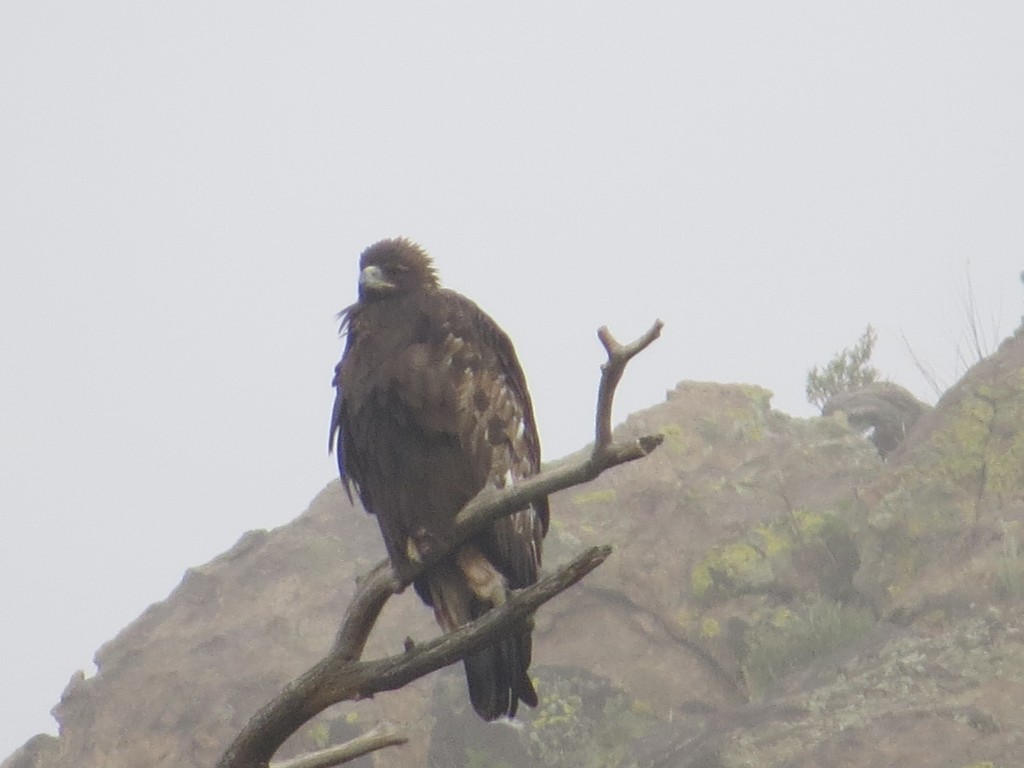
Mystery Eagle
When I got home I sent my pictures off to Randy. He wasn’t comfortable making the call. Then I sent them off to the big guns at the National Eagle Center in Wabasha, Minnesota. Education director Scott Mehus excitedly confirmed that I had, in fact, got my Golden Eagle lifer! More than that, he went on to explain subtle differences in beak coloration, leg feathers, and nape color that distinguish a Golden Eagle from the look-alike life stage of a Bald Eagle. Awesome! That made for three big (literally and figuratively speaking) lifer raptors for the trip!
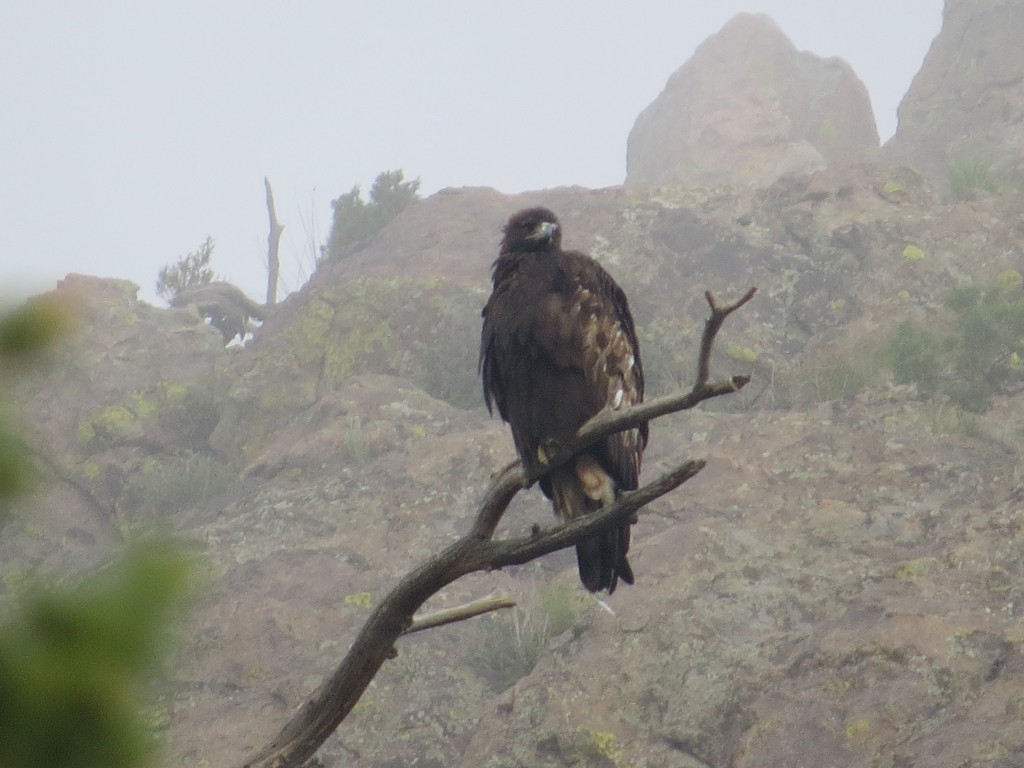
Golden Eagle!!
Evan was sound asleep while I was spotting and photographing these birds in the early morning. You can’t sleep in and expect to see the same things. I knew he wanted to see some of these birds, but birds move on. He seems okay with it. But when I told him I was waking up early the next morning to hunt for Western Tanagers again, he said he was in. He wasn’t going to miss another chance at this cool bird. I had another eBird report by Rich Miller of six of them on one forest service road in the San Isabel National Forest just north of Bishop’s Castle about 45 minutes away.
It was nearly impossible to wake Evan up that morning, and he promptly fell asleep in the car for the entire drive. The ride was incredible as I made my way south along a curving, climbing Highway 165. Conifer-studded mountains rose steeply on both sides of this road. I almost forgot I was bird-watching. In fact, I missed Forest Service Road 383 and had to turn around to find it.
I was excited to take this road. With a report of six individuals, the Western Tanager would have to be a sure thing. I decided to let Evan sleep until I saw one or something else that was good. The optimism of seeing one of these gorgeous birds started slipping the further I drove and the higher in elevation I went. I wasn’t seeing anything. Eventually I decided to give up and turn around. I stopped to check out some bird activity near a streambed. A roving flock of Mountain Chickadees was noisly chattering as they foraged for food. I woke Evan up so he could get this lifer. He lifted his head, saw one fly about 100 feet away, and said, “Yep, I saw it.” A similar scene played out later back at the yard when we picked up our Lesser Goldfinch lifer. Evan seems to be content with check marks for the sake of check marks instead of getting a good look at a bird. Not me.
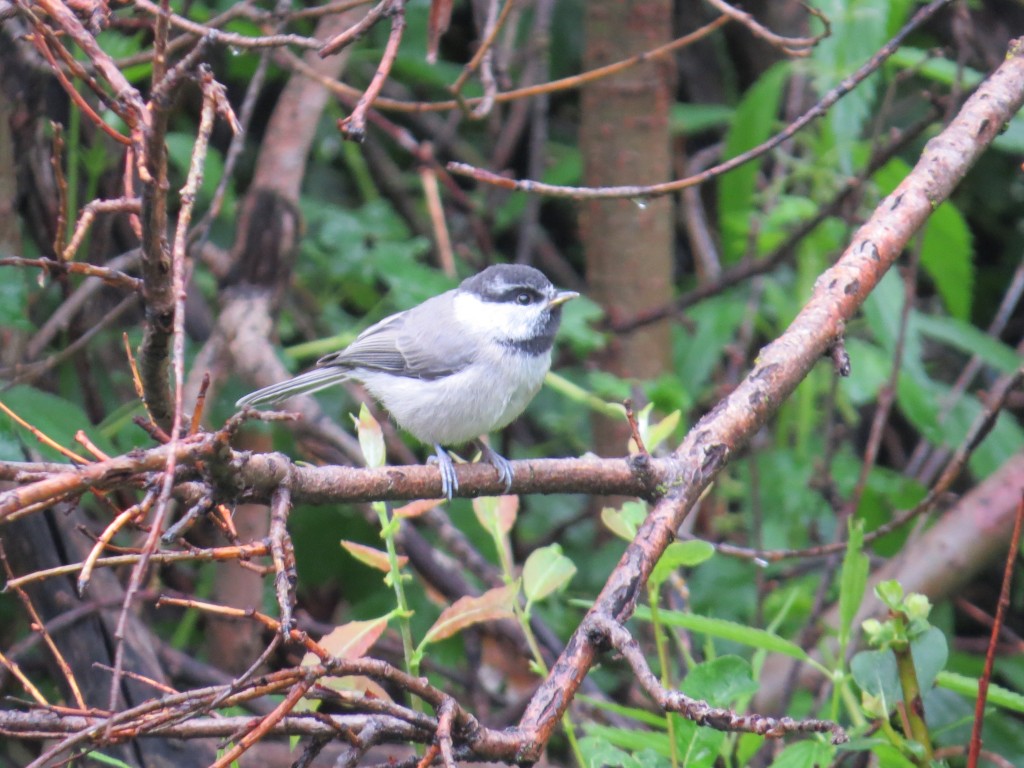
Mountain Chickadee
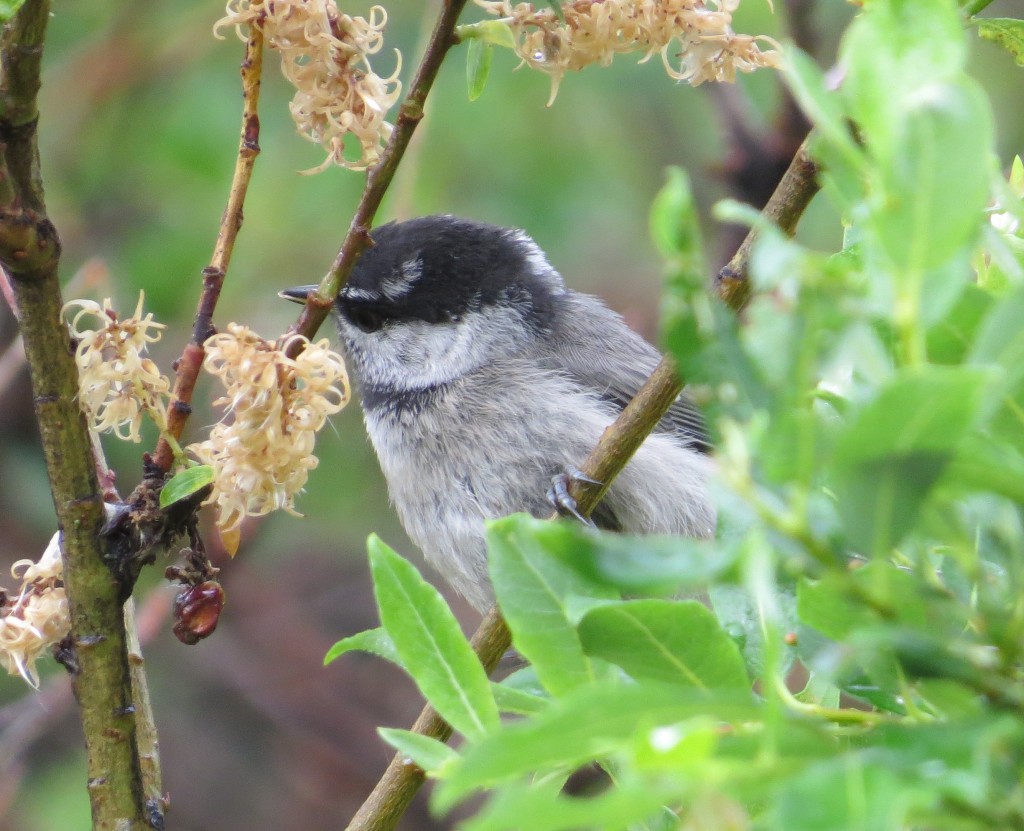 Moving on from this spot I kept up hope that we would see the tanagers on the way out. One bird I stopped to check out was interesting for me to see here in Colorado even though I’ve seen hundreds in northern Minnesota, a female Evening Grosbeak.
Moving on from this spot I kept up hope that we would see the tanagers on the way out. One bird I stopped to check out was interesting for me to see here in Colorado even though I’ve seen hundreds in northern Minnesota, a female Evening Grosbeak.
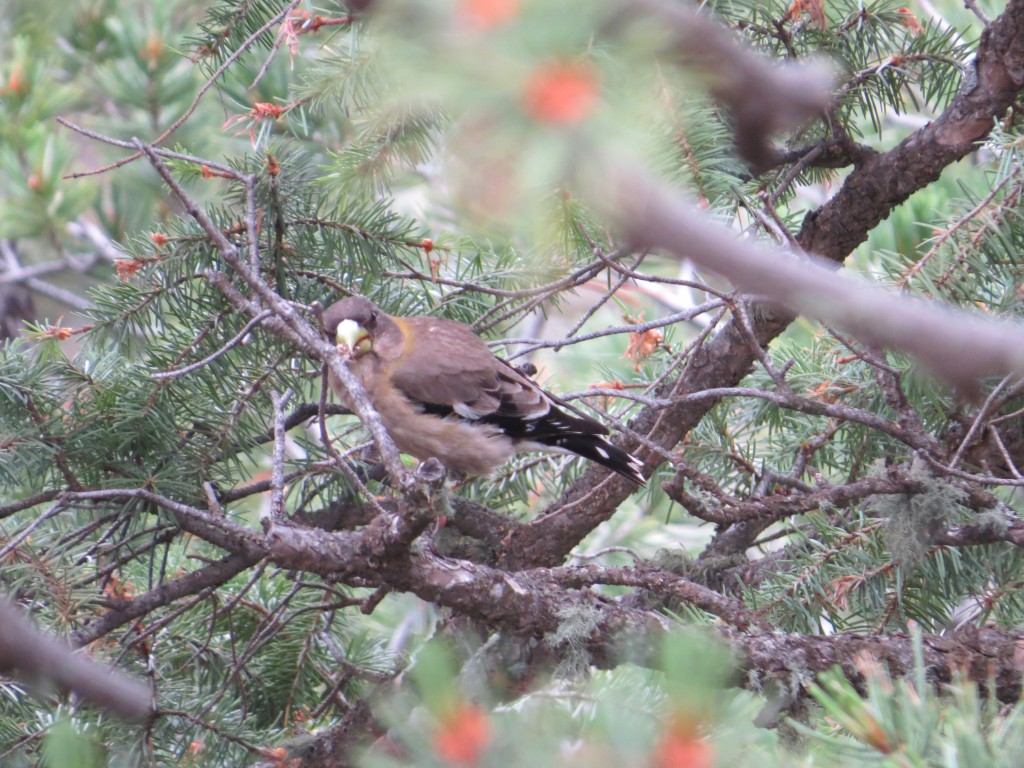
Evening Grosbeak Female
As cool as this was, Evan and I really just wanted to see that red-faced bird. Despite probability being in our favor by being on this road, it was not meant to be. Now hope was slipping that there would be no more Western Tanagers for this trip. As fun as it was to watch birds back at my aunt and uncle’s yard, like my aunt’s Mountain Bluebird pair that nest under the eaves and come out when she whistles, the habitat just wasn’t right for WETA.
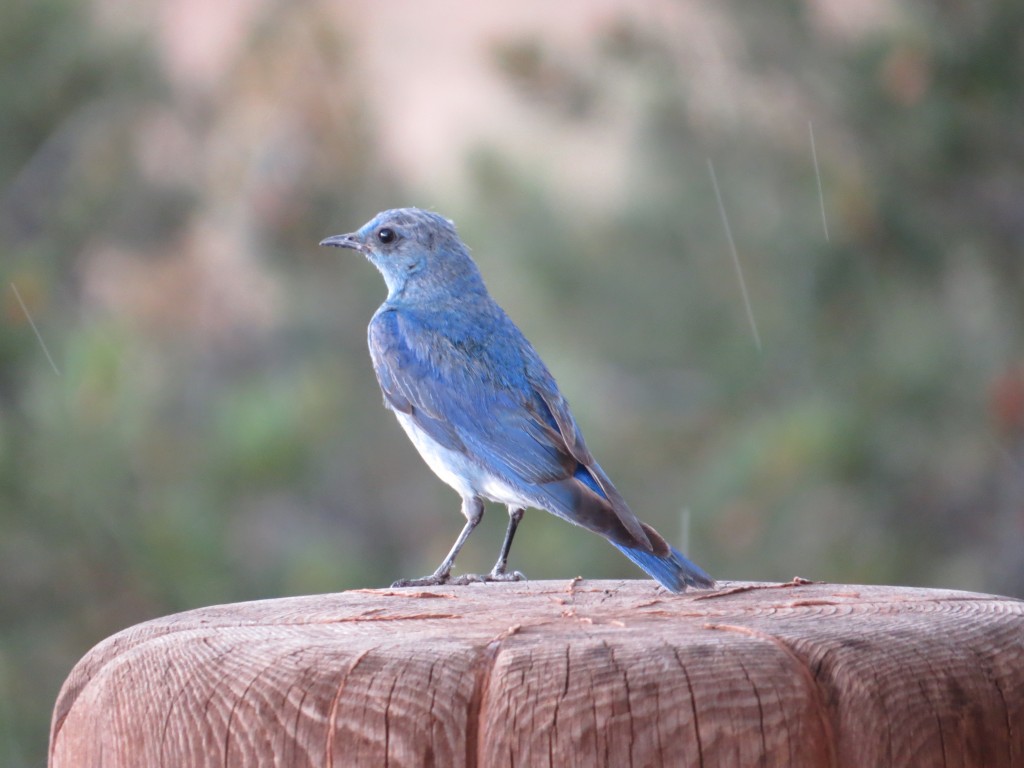
Aunt Carol’s “pet” Mountain Bluebird
But just when nearly all hope was gone and the car was all loaded to leave Colorado for good, Custer County saved its most exciting birding for the very end when we drove away from Jon and Carol’s house. So hang on for a wild ride (figuratively speaking, of course) in the next and final Colorado post.

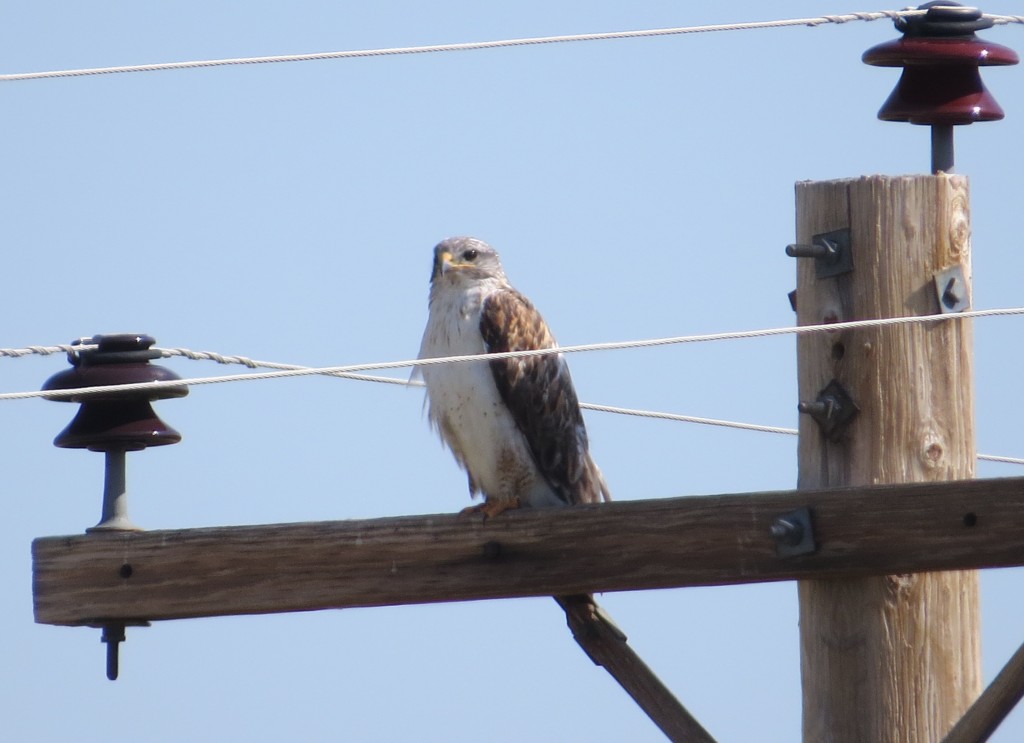
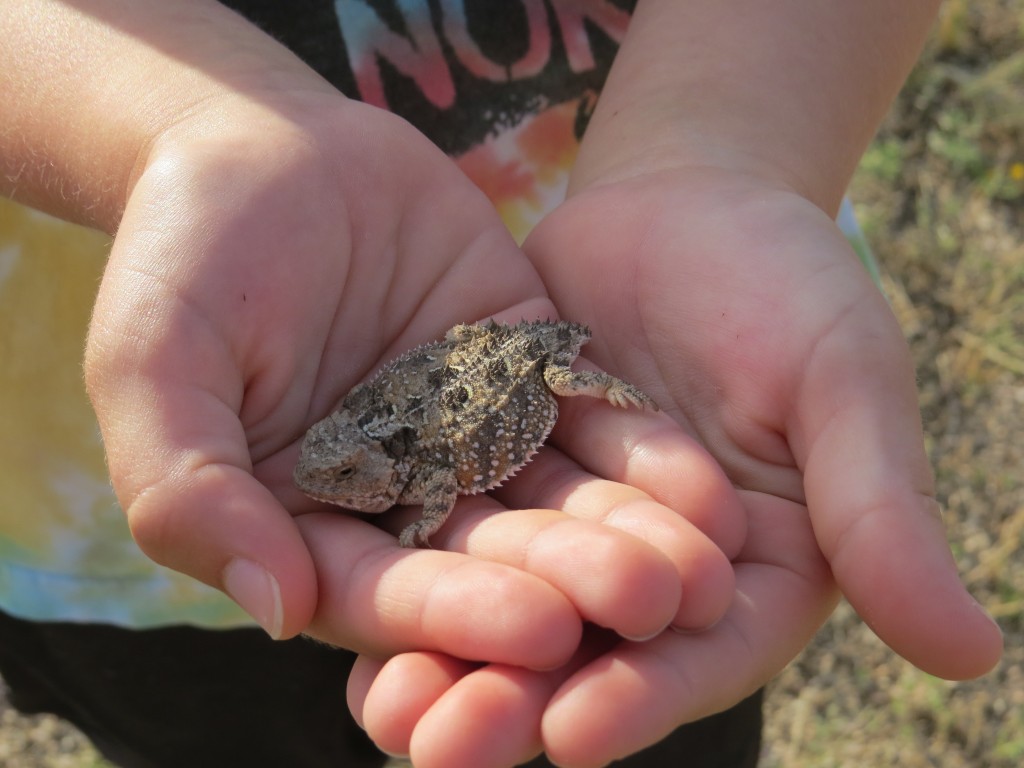 Evan’s cousin Andrew showed him the ropes for catching these cool lizards, and Evan caught this one all on his own. As someone who had cages full of lizards as a kid, I wanted to keep this one in the worst way. Even Melissa said it was cute. If Evan had asked, I couldn’t say no. But he didn’t ask, so there was no moral dilemma of the lizard variety.
Evan’s cousin Andrew showed him the ropes for catching these cool lizards, and Evan caught this one all on his own. As someone who had cages full of lizards as a kid, I wanted to keep this one in the worst way. Even Melissa said it was cute. If Evan had asked, I couldn’t say no. But he didn’t ask, so there was no moral dilemma of the lizard variety.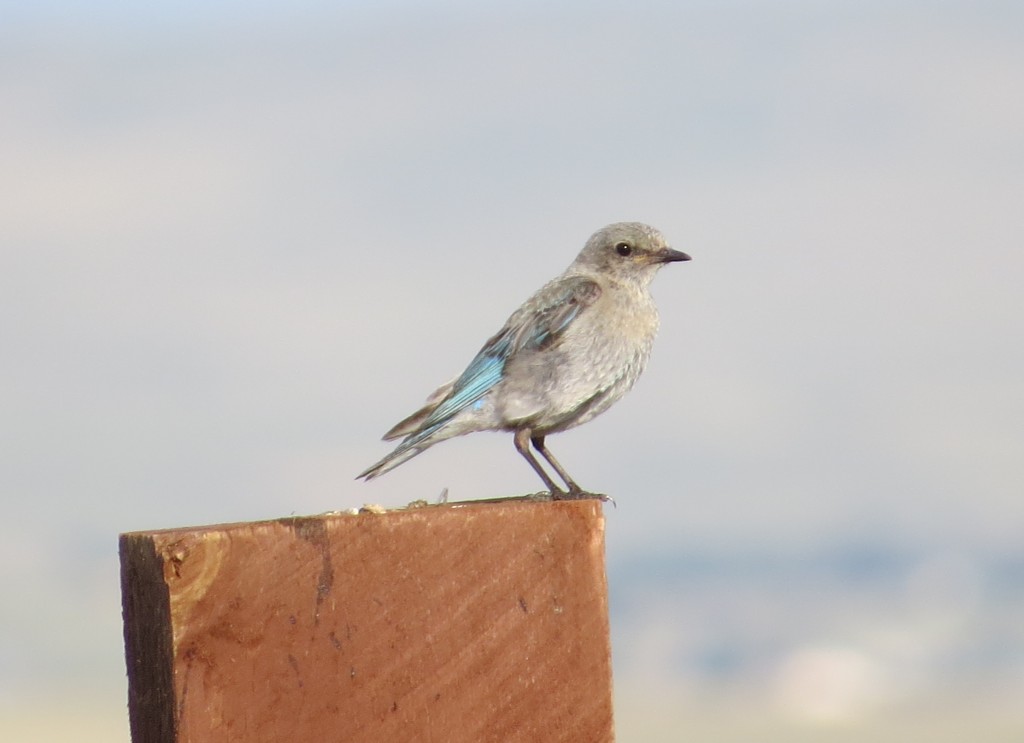
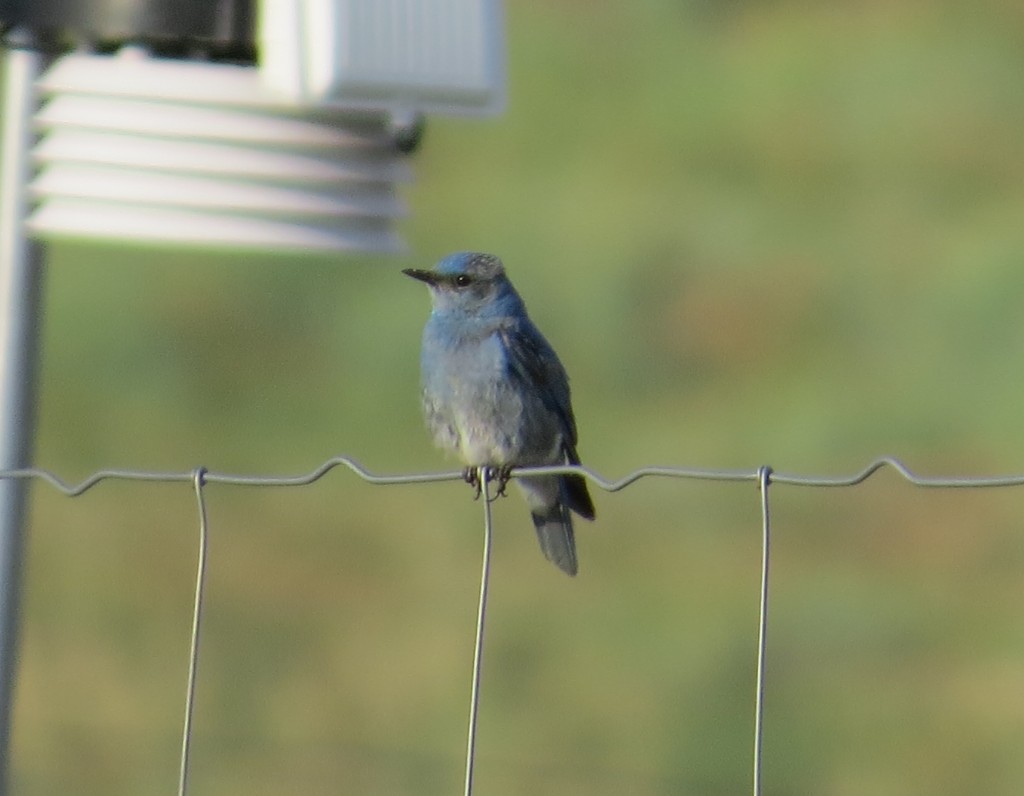
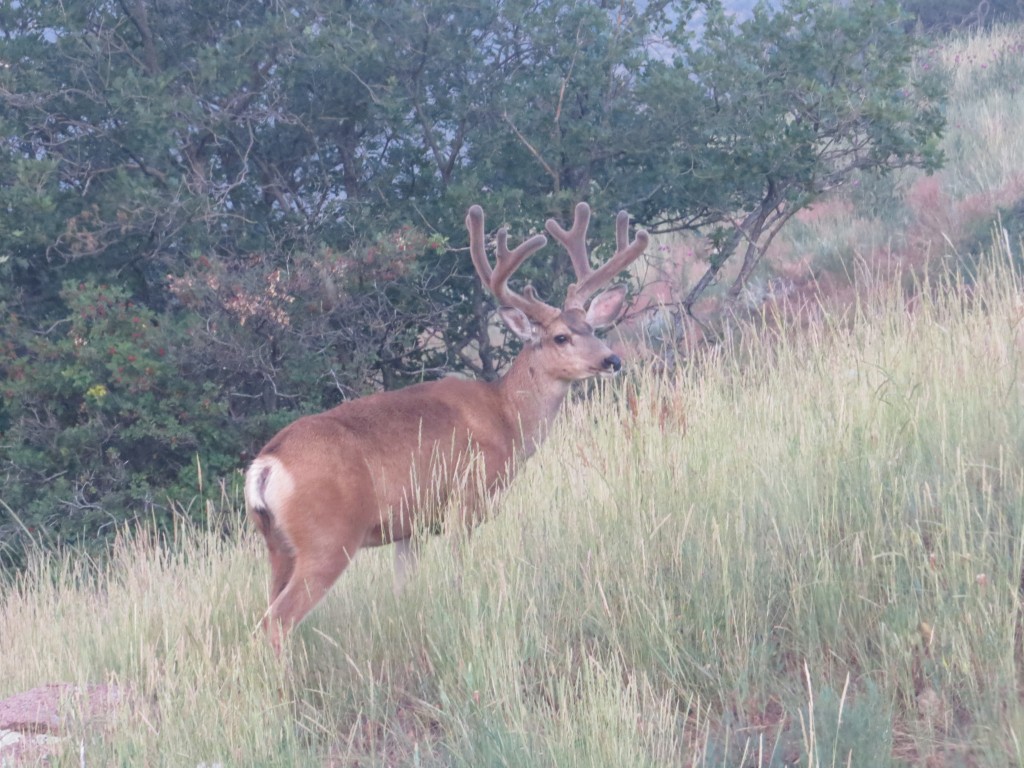
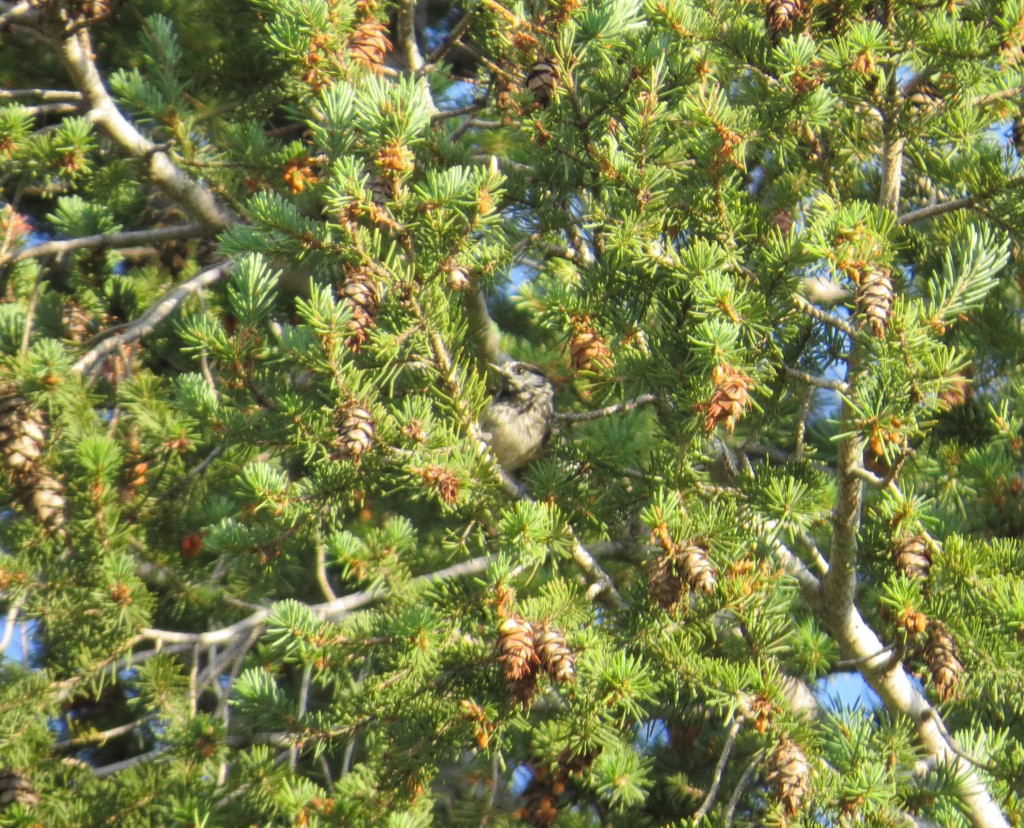
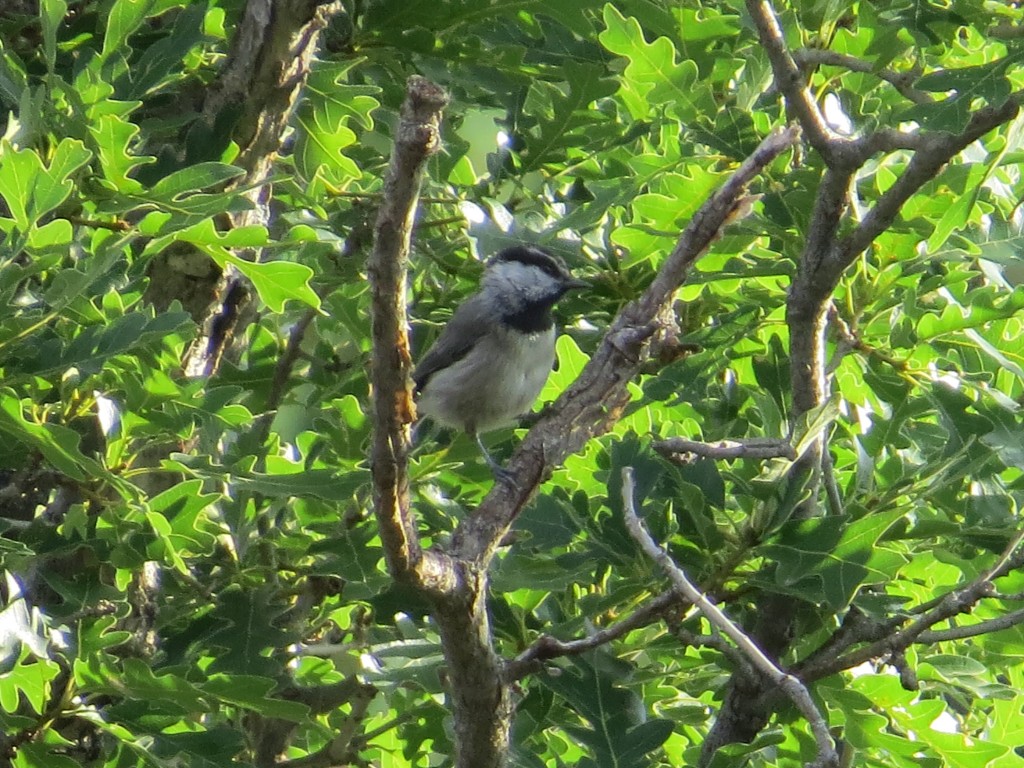 From reading the eBird reports I was expecting to find Western Scrub Jays. It took me awhile, but I found a couple of this life bird.
From reading the eBird reports I was expecting to find Western Scrub Jays. It took me awhile, but I found a couple of this life bird.